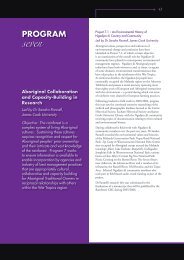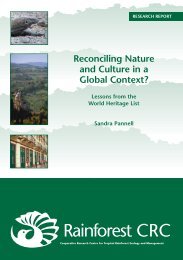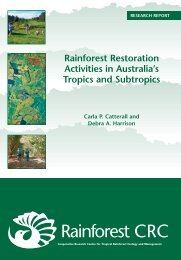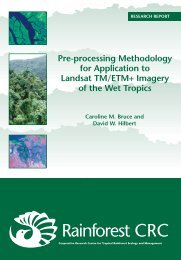Reconciling Nature and Culture in a Global Context? - Rainforest ...
Reconciling Nature and Culture in a Global Context? - Rainforest ...
Reconciling Nature and Culture in a Global Context? - Rainforest ...
Create successful ePaper yourself
Turn your PDF publications into a flip-book with our unique Google optimized e-Paper software.
S<strong>and</strong>ra Pannell<strong>in</strong>novative l<strong>and</strong> tenure framework” (loc. cit.). Val d’Orcia was heralded as a “model ofsusta<strong>in</strong>able rural development” <strong>and</strong> pa<strong>in</strong>t<strong>in</strong>gs were commissioned to depict the life of‘ord<strong>in</strong>ary people’ <strong>in</strong> this l<strong>and</strong>scape (loc. cit.). Val d’Orcia not only represented a prototypeagricultural system, but it was also regarded as the <strong>in</strong>carnation of Renaissance ideas <strong>and</strong>aesthetics about ‘l<strong>and</strong>scape beauty’ or bel paesaggio.This ideal l<strong>and</strong>scape was immortalised <strong>in</strong> Ambrogio Lorenzetti’s 1338-1339 fresco ‘Allegoryof Good Government: the Effects of Good Government <strong>in</strong> the City <strong>and</strong> the Country’,extend<strong>in</strong>g over three of the walls <strong>in</strong>side the Town Hall (‘Palazzo Pubblico’) of Siena. AsFrederick Hartt observes, the artist “wanted to br<strong>in</strong>g <strong>in</strong> the entire territory, off to a distanthorizon, <strong>in</strong> order to display the agricultural prosperity of the [Siennese] Republic” (1970: 93).In the vista of unfold<strong>in</strong>g fortified hills <strong>and</strong> farms, peasants are depicted tend<strong>in</strong>g v<strong>in</strong>es <strong>and</strong>harvest<strong>in</strong>g gra<strong>in</strong>s. This bucolic country scene contrasts with Lorenzetti’s detailed depiction ofthe city streets, alleys <strong>and</strong> squares of Sienna, which forms the other focal po<strong>in</strong>t <strong>in</strong> this artisticportrayal of the allegories of ‘good <strong>and</strong> bad government’. In contrast<strong>in</strong>g the city <strong>and</strong> thecountryside, Lorenzetti depicts “the hard-won harmony between man <strong>and</strong> nature whichmakes not only the l<strong>and</strong>scape of Italy but the art […] different from any other <strong>in</strong> the world”(Hartt 1970: 11). As Hartt po<strong>in</strong>ts out, Italian art of this period focused upon civic life whichwas “surrounded by a natural world which man is constantly try<strong>in</strong>g to dom<strong>in</strong>ate” (ibid: 12). AsHartt concludes, prior to this particular depiction of city <strong>and</strong> country:No such comprehensive panorama of the natural world <strong>and</strong> its human<strong>in</strong>habitants is known to us from the entire previous history of art, <strong>and</strong> certa<strong>in</strong>lynoth<strong>in</strong>g so ambitious was ever attempted later, save by the pa<strong>in</strong>ters of purely<strong>in</strong>formative historical decorative panoramas <strong>in</strong> the sixteenth century (1970: 91).Indeed, the artistic tradition of l<strong>and</strong>scape pa<strong>in</strong>t<strong>in</strong>g did not fully develop <strong>in</strong> Europe until the1500s <strong>and</strong> early 1600s 59 .THE EUROPEAN TRADITION OF LANDSCAPEThe art historian, Walter S. Gibson, identifies “the most important <strong>and</strong> <strong>in</strong>fluential l<strong>and</strong>scapetradition” (1989: xx) as orig<strong>in</strong>at<strong>in</strong>g <strong>in</strong> Antwerp <strong>in</strong> the early 1500s. This tradition is referred toas ‘world l<strong>and</strong>scape’ (Weltl<strong>and</strong>schaften) <strong>and</strong> is dist<strong>in</strong>guished by the representation of multipleviewpo<strong>in</strong>ts (or put another way, a lack of a one-po<strong>in</strong>t perspective), which firmly establishes itsaffiliation with the tradition of cartography. Accord<strong>in</strong>g to Gibson, l<strong>and</strong>scape “could not existas an <strong>in</strong>dependent category <strong>in</strong> art until it had been accepted as such by the public”(1989:xviii). In Europe, prior to 1500, l<strong>and</strong>scape served as a backdrop for human figures <strong>and</strong> theiractivities. After 1500, it is possible to plot the emergence of autonomous l<strong>and</strong>scapes –l<strong>and</strong>scapes devoid of humans. Although <strong>in</strong> the case of the l<strong>and</strong>scape traditions associatedwith Antwerp <strong>and</strong> Venice, human figures still featured, however, their relationship with thesett<strong>in</strong>g was reversed, with the l<strong>and</strong>scape itself dom<strong>in</strong>at<strong>in</strong>g the overall effect of the pa<strong>in</strong>t<strong>in</strong>g.In the European context, there is a strong allegiance <strong>and</strong> overlap between l<strong>and</strong>scape <strong>and</strong>map. Gibson (1989) l<strong>in</strong>ks the ris<strong>in</strong>g popularity of l<strong>and</strong>scapes with European voyag<strong>in</strong>g <strong>and</strong>expansionism <strong>in</strong> the 1500s <strong>and</strong> concomitant improvements <strong>in</strong> cartography. H<strong>and</strong> <strong>in</strong> h<strong>and</strong>with these developments, is a grow<strong>in</strong>g public enchantment with maps <strong>and</strong> globes as both ameans of vicarious travel <strong>and</strong>, given the pictorial composition of many maps, as forms of walldecoration.59 Claude Lorra<strong>in</strong> (1604/05-1682) is often described as the ‘first great master of European l<strong>and</strong>scapepa<strong>in</strong>t<strong>in</strong>g’.62
















